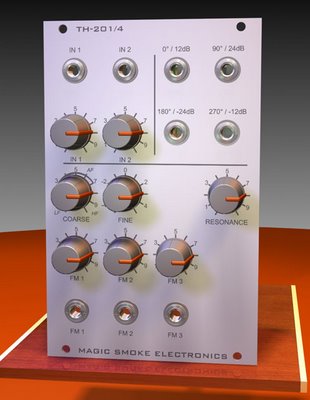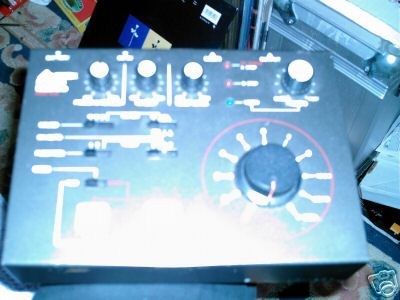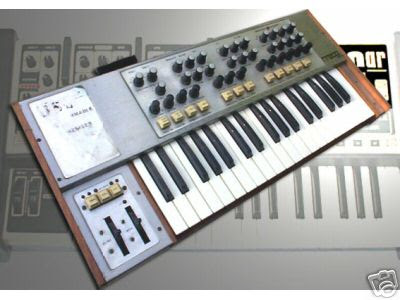
More info is up on the
Tom Oberheim website.
For the archives:
"Welcome to my new website! The word is getting around that I'll be reissuing my very first analog synth-- the Synthesizer Expander Module (SEM). The SEM has the same single-voice analog circuit design as the original - 100% analog! - and is paired with a versatile MIDI to CV converter that allows the routing of MIDI messages to the various control voltage inputs. I've been showing the prototype around a little and musicians love the sound.
I'll be posting more information soon but while you're here, please sign up for my email list by simply sending an email to:
tom (at) tomoberheim (dot) com
and I'll let you know when the product ships. The pricing is as follows:
* SEM with MIDI input and MIDI to CV routing panel (as shown in above photo): $899
* SEM with patch panel connections to internal inputs and outputs (no MIDI input, same as above photo but left panel controls are replaced by CV/gate/audio I/O patch panel): $749
* Basic SEM module with front panel (no case or power supply, good for drop-in replacement of original SEM): $599
Thanks for stopping by!
- Tom Oberheim"
Update: patch points via the AH list:
"just in case you are interested, the following is a list of the internal inputs and outputs that I plan to bring out to jacks:
SYNTHESIZER EXPANDER MODULE ELECTRONICS BOARD CONNECTOR LIST
CONN. PIN FUNCTION Direction
A1 VCO 1 - External Modulation Input
A2 VC0 1 - Sawtooth Waveform Output
A3 VCO 1 - Pulse Waveform Output
B1 VCO 1 - Control Voltage #1 Input
B2 Ground
B3 VCO 1 - Control Voltage #2 Input
C1 VCO 1 - Sync Output Output
C2 Ground
C3 VCO 1 - Sync Input Input
D1 VCO 2 - Control Voltage #1 Input
D2 Ground
D3 VCO 2 - Control Voltage #2 Input
E1 VCO 2 - External Modulation Input
E2 VC0 2 - Sawtooth Waveform Output
E3 VCO 2 - Pulse Waveform Output
F1 VCO 2 - Sync Output Output
F2 VCA - Control Input Input
F3 VCO 2 - Sync Input Input
G1 LFO Trigger Input
G2 Ground
G3 LFO Waveform Output
H1 VCF - Control Voltage #1 Input
H2 VCF - Control Voltage #2 Input
H3 VCF - External Modulation Input
I1 VCA Output Output
I2 Ground
I3 Output Amplifier Input Input
J1 VCF - HiPass Signal Output
J2 Ground
J3 VCF - Bandpass Signal Output
K1 Selected VCF Response Output
K2 Ground
K3 VCF - LowPass Signal Output
L1 External Audio Input #1 Input
L2 Ground
L3 External Audio Input #1 Input
M1 External Audio Input #2 Input
M2 Ground
M3 External Audio Input #2 Input
X1 ENV 1 - Output Output
X2 ENV 1 - Gate Input
X3 ENV 1 - Trigger Input
Y1 ENV 2 - Output Output
Y2 ENV 2 - Gate Input
Y3 ENV 2 - Trigger Input
Z1 +18 Volts Input
Z2 Ground
Z3 Ground
Z4 -18 Volts Input
tom o."
Update via the AH list:
"I am talking to a possible German distributor. I will advise you later.
SEMs will not be available until September.
A really cool mini-sequencer is in the design stage but will not be available until the end of the year because I have to get some SEMs done!
tom o."
 Update
Update via fotomoog in the comments of
this post:
"The SEM comes in three versions:
- version 1: SEM analog module with Midi to CV converter for modern Midi-based systems
- version 2: SEM analog module with patchpanel for systems which can supply an appropriate control voltage and gate or trigger signal
- version 3: SEM module alone, without case, power supply or interface module. The purpose of the version 3 SEM is really just to replace old SEMs in old Oberheims. I do not recommend trying to integrate just the SEM without the case and power supply into another situation. The main stumbling block would be that the SEM requires regulated +/- 18 volts.
www.audioMIDI.com is the exclusive dealer for the Tom Oberheim SEM. The links take you to their website where additional information is available. Also if you wish to pre-order an SEM, you can do that on the audioMIDI website.
Deliveries of the SEM begin sometime in September.
I will be updating my website (www.tomoberheim.com) on a regular basis. You might want to check it from time to time for additional information. I expect to have an FAQ and a short history of the SEM on the site soon.
I appreciate you interest!
Tom Oberheim
So, here is my calling arround the worl : who can DIY a power-in-out bay rack to plug 1 or 2 new SEM ?"
Update via James Husted on AH: "Two SEMs can be placed next to each other in a 19" rack but the chassis behind the panel will exceed the standard width restrictions for 19"racks (to clear the rails used my most everybody). You can shave off some of the extra panel width that over hang the PCB widths and it will work just fine though. Remaking the front panels on the older SEMs is not trivial - there are standoffs swaged into them and unless you have access to a press (and PEM standoffs) it will not be easy. I once looked into a super cheap layout with no rear chassis - relying on the rack for protection - that was just a big hole in a 6U panel and If I remember correctly it would have just fit.
If you want some metalwork designs that others have made racks from - go to my Oberheim Databank page and choose custom metalwork at the bottom:
http://web.me.com/ersatzplanet/ErsatzPlanet/Pages/ObiePages.html"
 "Magic Smoke is the exclusive licensed source of Thomas Henry's books on do-it-yourself musical electronics as well as the source for exclusive analog synthesizer modules and kits. For starters, we're bringing out Thomas's classic books plus his fantastic new voltage controlled filter."
"Magic Smoke is the exclusive licensed source of Thomas Henry's books on do-it-yourself musical electronics as well as the source for exclusive analog synthesizer modules and kits. For starters, we're bringing out Thomas's classic books plus his fantastic new voltage controlled filter."

































































